FULL REVIEW: Toyota Celica ZR VVTL-i 2ZZ-GE (00-05)
In this blog entry, I'm going to cover 2000 to 2005 Toyota Celica ZR VVTLi. It's QUITE RARE in Malaysia, as UMW Toyota DID NOT IMPORT the car to Malaysia. Instead, it's Grey importers (Eg. NAZA, MOFAZ) who imported few hundred units as Unregistered car. Today, as at 15 January 2010, a used Celica is your for the following prices:
Year......... 2000........2001.....2002.....2003....2004/05 (Unreg)
Price (RM):82k..........89k.......98k.......110k...125k/135k
As usual, I don't have a TEST car to see/drive/feel and BRAG about. All is NOT LOST, I dished out a SUPERTEST from GOAUTO Australia. In addition, I also came up with 5 owner's review from ALL OVER THE WORLD. Enjoy:
SOURCE 1: http://www.goauto.com.au/mellor/mellor.nsf/story2/96B13DEE38D6527CCA2569DF0013AB9C
SUPERTEST: Toyota Celica ZR VVTLi
Model release dates: November 1999 - March 2006

Overview
While previous generations typically offered more show than go, the new model is a firecracker.
Complementing the cracking 140kW powerplant is a taut chassis that delivers superb levels of grip and handling.
But there's a catch: Celica only delivers the goods in six-speed manual form.
The optional four-speed auto is simply not up to the task of keeping the high-revving 1.8-litre engine on the boil.
Previous model
Toyota has messed with the Celica since day one, resulting in the hairdresser image even though some models have been anything but.The 1994 version brought together most elements, especially handling, but the front-drive, 100kW 2.2-litre Camry engine was quite pedestrian.
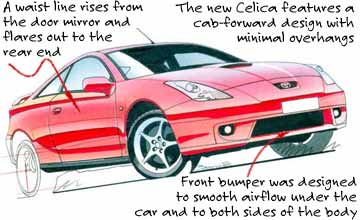
The Car
THE nice little "home" girl with the hourglass figure became an angry young street urchin in the latest generation Celica. It's smaller, lighter, tauter and 10 times meaner than sweet number six, sporting a No.1 clipper head shave, sharp eyes and a broken nose. The look is the work of stylists from Toyota's Calty design centre in California. The car is 90mm shorter and 15mm narrower than the model it replaces, even though its wheelbase is 65mm longer. At the front end, a deep channel runs from the small grille aperture up the centre of the bonnet to a (fake) air intake. Long, triangular four-lamp head light clusters with a projector-type low beam and multi-reflector high beam are used.The roof line is emphasised near each front seat, and bends radically down toward the rear hatch. The wing, standard on both models, and wrap-around "crystalline" tail lights dominate Celica's rear end, though the thick rear pillar and huge spoiler tend to retard rear visibility.

The Car - Seat Plan
DESPITE being shorter and narrower, the Gen VII Celica's longer wheelbase has brought with it more interior room ... relatively speaking. Gen VII has more interior space than Gen VI, with front legroom up 10mm to 1315mm. Overall height has increased by 10mm to 1315mm and front headroom is up as a result, by 31mm on non-moonroof models and 11mm with the hole in place. Despite rear headroom having increased slightly by moving the rear header rail 50mm forward, rear seat space - in all directions - is suitable for children only. Toyota describes the interior as a 'cross-over' cockpit, designed to create an individual experience for both the driver and front passenger.Did you know?
This is the seventh generation of Celica, stemming from the 1.6-litre Gen I back in 1971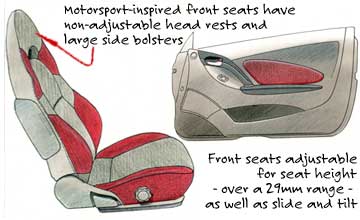
The Car - Seats
THE Celica's front seats are adjustable for seat height - over a 29mm range - as well as slide and tilt. The front buckets are covered with a 'Jersey' fabric, consisting of black material in the centre and coloured highlights (blue for SX and red for ZR) for the bolster sections. Side airbags, standard on ZR and optional on SX, are located in the front seats.The front pews have non-adjustable headrests and large side bolsters. S-springs and a sub-wire across the lumbar area were incorporated into them to provide additional comfort and support. High-density, low-rebound pad material was also used for the seat cushion pad to absorb vibration. The rear bench seat has flat woven amethyst trim.
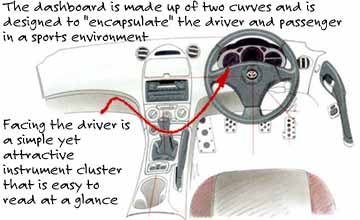
The Car - Dash
THE Celica dash is designed to "encapsulate" the driver and front passenger. Instrument graphics are orange on black, with LCD displays, also in orange, used for the fuel and temperature gauges and odometer and trip meters. Automatic models have a transmission indicator in the instrument panel and a separate display within the analogue speedo arc. A leather-clad three-spoke steering wheel, plus a leather-clad gear knob, add to the sporty ambience. An in-dash storage box with lid creates a big area of space between the digital clock and stereo.
The Car - Controls
THE Celica's radio is prominently positioned with big buttons and lettering making it a snack to operate. The steering wheel for models with automatic transmission has shift buttons for sequential-manual gear selection. Steering wheel adjustment is restricted to tilt only, however it moves without the need to slot into pre-set notches. The cruise control stalk is straight from the Toyota spare parts bin.External mirrors are adjusted from an electronic directional pad underneath the driver's door grabhandle. The power window switches feature a one-touch auto up with jam protection for the driver's window. The windows can also be closed after the ignition is turned off. Variable intermittent wipers and a rear windscreen wiper and demister are standard on all Celica models.
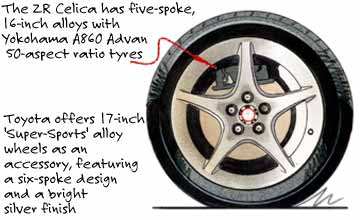
The Car - Wheels/tyres
THE ZR Celica has petite five-spoke 16-inch alloys with Yokohama A860 Advan 50-aspect ratio tyres. The SX 15-inch alloy wheel design consists of five dual spokes suitable for Bridgestone Potenza 55-aspect ratio tyres.
The Car - Luggage
BOOT space is hardly cavernous but acceptable for a coupe of this size. Luggage capacity for the Gen VII Celica has increased 14 per cent (or 40 litres) over the preceding model to 323 litres. The rear loading height is now down to 786mm which improves access to the cargo area. The luggage area has a flat load floor, an under-floor storage area, luggage tie-down hooks, an oddments tray and a hook for a shopping bag.The rear bench seat split-folds 50/50 and has red-coloured "warning" latches which, when unengaged, remain raised above the seatback. Child restraint anchorage points are built into the rear seatback and neatly located inside by flush-fitting covers. It is an ideal location, minimising intrusion into the cargo area.
Did you know?
Celica's overall dimensions are smaller than its predecessor - it is 90mm shorter and 15mm narrower - but its wheelbase has been stretched by 65mm to 2600mm.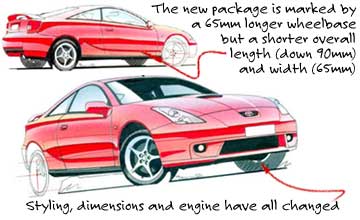
The Car - What's changed
A LOT has changed with Celica, with styling, dimensions and engine top of the list. Gone are the soft, flowing lines of the former "hairdresser's car" and in its place is an unashamedly aggressive-looking car with sharp, machined surfaces, four-corner wheel positioning and a striking headlight cluster.The new package is marked by a 65mm longer wheelbase but a shorter overall length (down 90mm) and width (65mm). At least for the time being, Celica has lost its underwhelming Camry engine status and replaced it with an all-new and much more performance-oriented 1.8-litre donk.

The Car - Stand out features
THE enormous, all-encompassing triangular head light cluster commands attention at the front end of the car. The cluster has built-in front signal lamps in skeleton extensions and features a projector-type low beam and multi-reflector high beam. If orange on black is your thing, you won't be disappointed with the array of instruments which confronts you from the driver's seat. The speedometer and tachometer have orange needles and lettering.The speedo arc uses a large orange typeface at 20km/h increments, and in automatic models also houses the gear selected when in semi-automatic mode. The "orange crush" continues within the LCD display that encompasses fuel and temperature gauges, transmission indicator (on the autos), odometer and twin trip meter.
Did you know?
The Celica colour range is: Glacier White, Cold Steel, Ebony, Raven, Cherry and Galaxy Blue. The new Raven colour has two types of colour pigment - black and blue - in the top clear coat.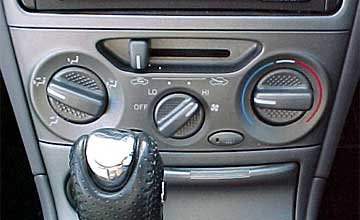
The Car - Climate control
QUITE unbelievably for a car in this market segment, air-conditioning is a dealer-fit option for both Celica models. Celica uses conventional rotary dials for controlling the cabin temperature however the digital air-conditioning read-out is unnecessarily complicated.
The Car - Sound system
THE standard Celica audio system has an electronic touch-tune AM/FM radio with a single-slot CD player with repeat, random and skip/search functions. ZR adds a cassette player with a six-disc in-dash CD changer. Sturdy construction and special fluid dampening aims to reduce the effect road imperfections have on sound quality.The system has motorised auto-loading and eject and random/repeat/scan functions. Six speakers are positioned around the cabin, including high-mounted tweeters for optimal high-frequency clarity. SX owners can purchase either a three-disc or six-disc in-dash CD changer as an accessory.

The Car - Security
CELICA has remote central locking as standard, along with an engine immobiliser incorporating fuel and ignition cut-out. A cover keeps the contents of the boot hidden, while the standard-fit radio is security coded for added protection against theft.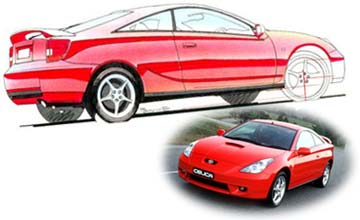
Our opinion
 We like
We like Looks, performance, handling
 Room for improvement Poor rear visibility, auto feels sluggish
Room for improvement Poor rear visibility, auto feels sluggishBy GAUTAM SHARMA 05/01/2000
THE new Toyota Celica is likely to attract buyers who would never have considered its predecessors.
No longer does it rely purely on swoopy good looks to set it apart from the more mundane sedans and hatches in the Toyota line-up.
The languid performance and uninspiring handling of the outgoing "four-eyed" Celica have made way for outstanding dynamics that are more than a match for any other sub-$50,000 coupe.
Its straight-line performance might not be up there with the Nissan 200SX, but the Celica is satisfyingly quick all the same, being capable of sprinting from standstill to 100km/h in just over seven seconds.
At the car's heart lies a seemingly race-inspired 1.8-litre engine that cranks out 140kW at a dizzy 7600rpm - but perhaps more amazing is that peak torque of 180Nm occurs just 800rpm lower.
The powerplant has an almost turbo-like delivery, coming into its own in the upper half of the rev range thanks to Toyota's VVTL-i variable valve timing system.
Exceeding 5000rpm results in the formerly muted engine note changing into a hard-edged roar. The increase in decibels is accompanied by a dramatic surge in performance as the tacho needle rapidly sweeps towards the redline.
The somewhat peaky delivery of the engine means the close-ratio six-speed gearbox needs to be stirred frequently to obtain optimum performance.
This is not an altogether unpleasant task as the six-speeder delivers quick, slick changes with a bit of practice. The six ratios are closely stacked, making it easy to keep the engine in the optimum rev range.
But achieving smooth progress in stop-start situations requires familiarisation with the sharp-biting clutch and abrupt fuel cut-off on a trailing throttle.
The optional automatic transmission virtually nullifies the benefits of the high-revving engine as four ratios are simply not enough to keep it on the boil. Consequently, the self-shifter is not worth considering unless you have a dysfunctional left leg or chronic dislike for changing gears.
Perhaps the most eye-opening aspect of the new Celica - apart from the styling - is the sheer competence of the chassis.
It quickly becomes evident from its firm ride that this car is far tauter than any of its predecessors.
Although the ride seems busy at low speeds, the plus side is the Celica has minimal body roll and feels very composed and well tied down at highway speeds.
There is nary a trace of understeer even when hurled into corners at alarming speeds. It turns in sharply and there is little evidence of torque steer, even when the accelerator is stomped on.
It should be noted that the test car was the up-spec ZR model and benefited to some degree from its taller 16-inch wheels shod with low-profile 205/50R16 tyres.
Making the most of the ample grip on offer is simplified by the well-weighted and communicative steering which seems to telegraph what is happening at the front wheels to the driver's fingertips.
In keeping with the overall character of the new Celica, the driver is seated low, in true sports-car style.
The only problem this poses is rear visibility is limited, largely due to the car's high rump. Reverse parking becomes an exercise in guesswork as it is virtually impossible to see the car in the space behind.
Comfort is one of the car's plus points and the hip-hugging bucket seats offer plenty of lateral and lumbar support, and are well suited to long trips.
Facing the driver is a simple yet attractive instrument cluster that is easy to read at a glance. The overall cabin layout is understated although interesting use of curves and contours sets it apart from other Toyota offerings.
It is externally that the Celica makes its most dramatic statement with its bold, edgy styling completely at odds with its predecessor's rounded, organic lines.
There is no middle ground with this Celica - you will either love or hate the way it looks.
The aggressive nose is dominated by a gaping mouth, large triangular headlights and air intake sculpted into the steeply sloping bonnet. The chunky, squared-off tail is similarly menacing, lending the car a squat, purposeful stance.
But unlike most previous Celicas, this car actually has the go to match the show so you need not feel like a poser when driving it.
The car's overall dimensions are smaller than its predecessor - it is 90mm shorter and 15mm narrower - but its wheelbase has been stretched by 65mm to 2600mm.
In theory, this should create greater interior space, and it does, but the rear seats are still suitable for short trips only - for not very tall passengers.
Luggage space is quite generous at 323 litres, enough to comfortably swallow a couple's belongings for trips away.
Economy is one of the car's fortes and it excels on the highway, covering nearly 600km between tankfuls.
Overall, the Celica offers striking looks and sufficient performance and handling to make it a fast, safe and enjoyable car across twisty roads.
Its fun factor is backed up by Toyota reliability and a presumably strong resale value.
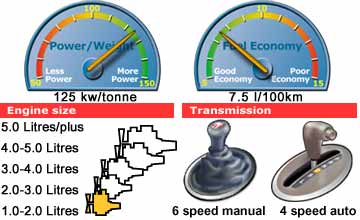
Mechanical
CELICA'S inline four-cylinder engine is transversely mounted and drives the front wheels.
Mechanical - Engine
ALL Celica models share the one mechanical package, and the Yamaha-built 1.8-litre, 16-valve DOHC four-cylinder engine is a highlight. It produces an impressive 140kW at 7600rpm and 180Nm at 6800rpm - redline arrives at 8000rpm - and while signifying a hefty reduction (16Nm) in torque from the previous "Camry" 2.2, variable valve timing (VVT-i) has entered the equation along with a high-lift second camshaft which starts throwing punches at 6000rpm (hence the "L" in VVTL-i on the engine cover).The result is the quickest non-turbo Celica ever, good for 7.6sec in the 0-100km/h burst; Gen VI was closer to 10. The current engine, coded 2ZZ-GE, has 40 per cent more power than the 2.2-litre engine it replaced, and the power-to-weight ratio has improved by 45 per cent. A flow-down from the Lexus luxury car program and the Prius hybrid vehicle, VVTi continually varies the intake valve timing to provide ideal valve timing (and hence ideal engine characteristics) across a range of driving conditions.

Mechanical - Suspension
CELICA'S all-new rear suspension and improved front suspension is claimed to deliver better stability, turn-in, steering feel and ride comfort. Rather than use MacPherson struts on the rear, Toyota has introduced a double wishbone suspension. The front continues with MacPherson struts. The new front suspension has L-shaped lower arms and low-pressure gas-filled dampers with a linear control valve - the latter ensures changes to damping force are constant at low damper velocities and aims to maximise driving stability and ride comfort.Celica's front suspension hardware also includes a ball-jointed stabiliser bar and special rubber bushings to improve steering feel. The double wishbone rear suspension controls wheel movement through the full suspension stroke, aiming to ensure maximum tyre contact with the road.
Rear suspension geometry includes a toe-correcting function to optimise turning stability and straight-line stability under brakes.

Mechanical - Electronic system
THE new Celica has a "multiplex communications network" designed to improve vehicle functions while reducing the complexity of the wiring harness (and therefore reduce weight). Celica also has dedicated electronic control units (ECUs) for the engine, body and combination meter. They control vehicle functions as diverse as the transponder engine immobiliser and wireless door locks. The cruise control has an actuator which directly controls the throttle valve; there is no movement of the accelerator pedal while cruise control is in operation.Did you know?
Celica's electronic and electrical systems have separate fuses for each electrical sub-system, for added reliabilityMechanical - Transmission
THE new Celica is the first Toyota in Australia with a six-speed manual transmission - standard on both SX and ZR models - and the first with an electronically controlled four-speed automatic featuring a sequential manual shift option (called E-shift). The manual has close ratios from first to fifth gears and a tall sixth gear for better fuel economy when cruising at highway speeds. Forward gears in the manual transmission are constant mesh, which use an inertia lock key type synchromesh mechanism.Double-cone synchromesh on the first-second change aims to improve shift quality and gearbox durability. On the auto, gears can be shifted using the buttons on the steering wheel. Downshift switches are located on the front of the steering wheel and upshift buttons are located on the rear surface of the tiller. The transmission calculates throttle opening angle and acceleration rate to determine whether the vehicle is travelling uphill and then adjusts the gear selection if necessary.
Did you know?
A spring-loaded mis-shift function has been adopted for the manual transmission to prevent mis-shifting into reverse gear when selecting either first or second gear from neutral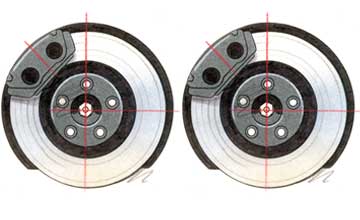
Mechanical - Brakes
CELICA'S brake package includes 275mm diameter ventilated disc brakes with piston-eccentric type callipers and 269mm solid rear discs. Four-channel, four-sensor ABS anti-lock brakes with electronic brake force distribution (EBD) are standard on ZR and linked with the safety pack on SX. Toyota claims Celica's stopping distances have been reduced as a result of to the car's reduced weight, improved grip and more efficient braking system.Electronic brake force distribution (EBD) replaces a load-sensing, proportioning and by-pass valve. The EBD control uses the ABS control unit to achieve a more ideal brake force distribution between the front and rear wheels, according to road conditions (available traction) and vehicle load. It allows front and rear braking force to more closely match the ideal curve under all vehicle load conditions. EBD also controls brake forces to the right and left wheels when braking in corners.

Mechanical - Steering
CELICA has engine-speed sensitive power-assisted rack and pinion steering, with 2.9 turns lock-to-lock. The steering has been re-engineered and includes a new compact, lightweight vane-type steering pump. The car's shorter overhangs and lighter weight are also said to contribute to improved steering response. Steering wheel vibration has been reduced by the adoption of a high-stiffness instrument panel reinforcement and steering column assembly, and a high-stiffness, lightweight steering wheel. The steering column is five-way energy absorbing, with a lower bracket, energy absorbing plate, breakaway bracket, contractile main shaft and contractile intermediate shaft. Celica's steering column has stepless tilt adjustment.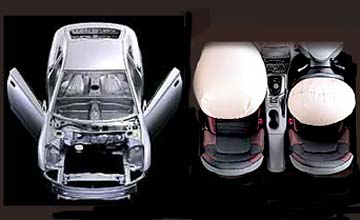
Safety
DUAL airbags and force-limiting front seatbelt pretensioners are standard equipment on all new Celica models while side airbags, contained within the front seats, are standard on ZR and optional on SX. The body has been reinforced significantly to improve performance in frontal and side impacts. High-strength sheetmetal is used around the car. Anti-intrusion beams are located in each door.The new model features a brake pedal retraction system, designed to minimise injury in frontal impacts. Warning lamps are provided for unbelted occupants, door ajar and hatch ajar. The rear seatbelts have an automatic locking retractor designed to hold child restraints and baby capsules firmly in place. Celica is a product of Toyota's Global Outstanding Assessment (GOA) program which concentrates on improving occupant protection, particularly in front end collisions.
END OF GOAUTO Australia's Article/SUPERTEST.
SPECIFICATIONS:
ENGINE:
Type: 2ZZ-GE
1794cc, in-line 4, EFI DOHC 16 valve VVTL-i
Bore x stroke: 82mm x 85mm
Compression ratio: 11.5:1
Max Power: 189hp (141kw) @7600rpm
Type: 2ZZ-GE
1794cc, in-line 4, EFI DOHC 16 valve VVTL-i
Bore x stroke: 82mm x 85mm
Compression ratio: 11.5:1
Max Power: 189hp (141kw) @7600rpm
Max torque: 180Nm@6600rpm
- Front: Independent MacPherson struts with lower L- arm, coil springs and stabiliser bar
- Rear: Independent double- wishbone with coil springs, gas shock absorbers and stabiliser bar
SUSPENSION:
- Power-assisted rack and pinion
- Turns lock to lock: 2.9
- Turning circle: 10.4 metres
STEERING:
- Length: 4335mm
- Width: 1735mm
- Height: 1315mm
- Wheelbase: 2600mm
- Track, front: 1490mm
- Track, rear: 1480mm
- Kerb weight: 1120kg (1155kg auto)
DIMENSIONS:
Performance:
Top speed: Electronically Limited to 190km/h (JDM Spec) -
146mph (233km/h) - UK-spec 6 speed manual (4 speed auto -NA-)
0-100km/h: 7.2 seconds (6 speed manual), 8.5 secs (4 speed auto)
END OF SPECIFICATIONS.
Without further ado, let's proceed to Owner's review (8 of them) from Australia, North America, UK & Ireland.
DELETED DUE TO COPYRIGHT ISSUES WITH THIS WEBSITE. Surf to:
http://www.carsurvey.org/reviews/toyota/celica/
To read the owner's comments.
DELETED DUE TO COPYRIGHT ISSUES WITH THIS WEBSITE. Surf to:
http://www.carsurvey.org/reviews/toyota/celica/
To read the owner's comments.
SOURCE 1: http://www.goauto.com.au/mellor/mellor.nsf/story2/96B13DEE38D6527CCA2569DF0013AB9C
SOURCE 2: http://www.carsurvey.org/reviews/toyota/celica/





Australia Car Toyota Club is a team of enthusiastic Toyota owners who have come together, to share their experiences with other Toyota owners.please visit:http://goo.gl/CxGZUL
ReplyDelete